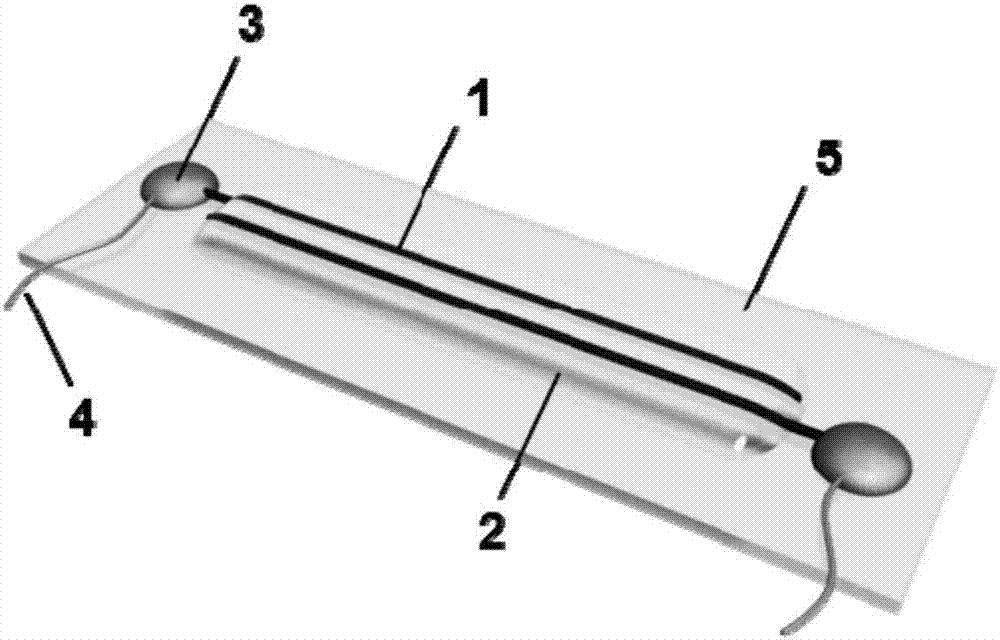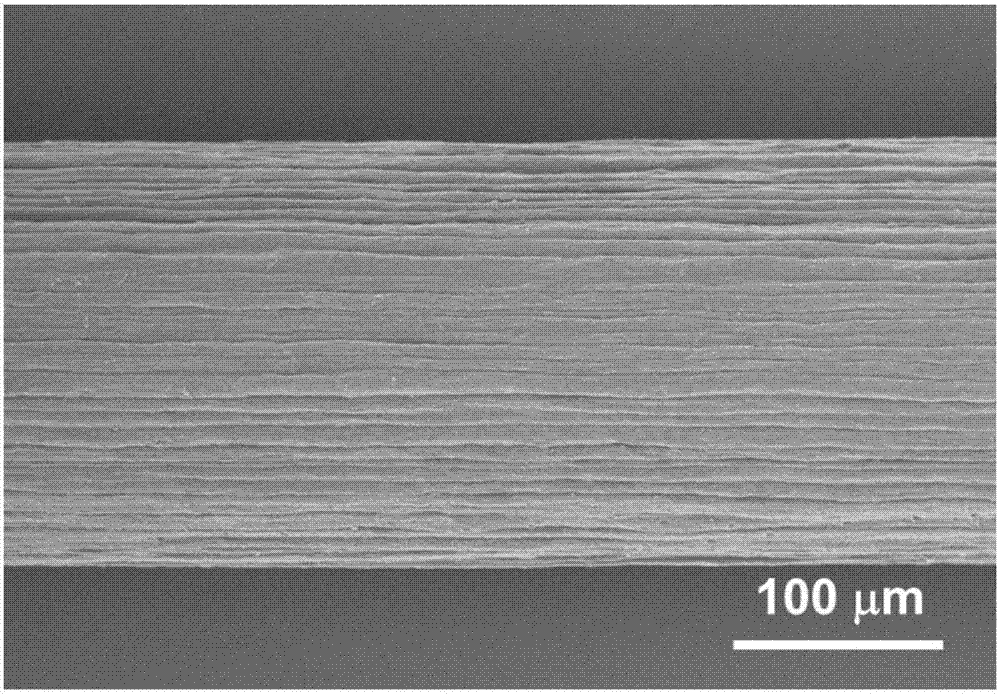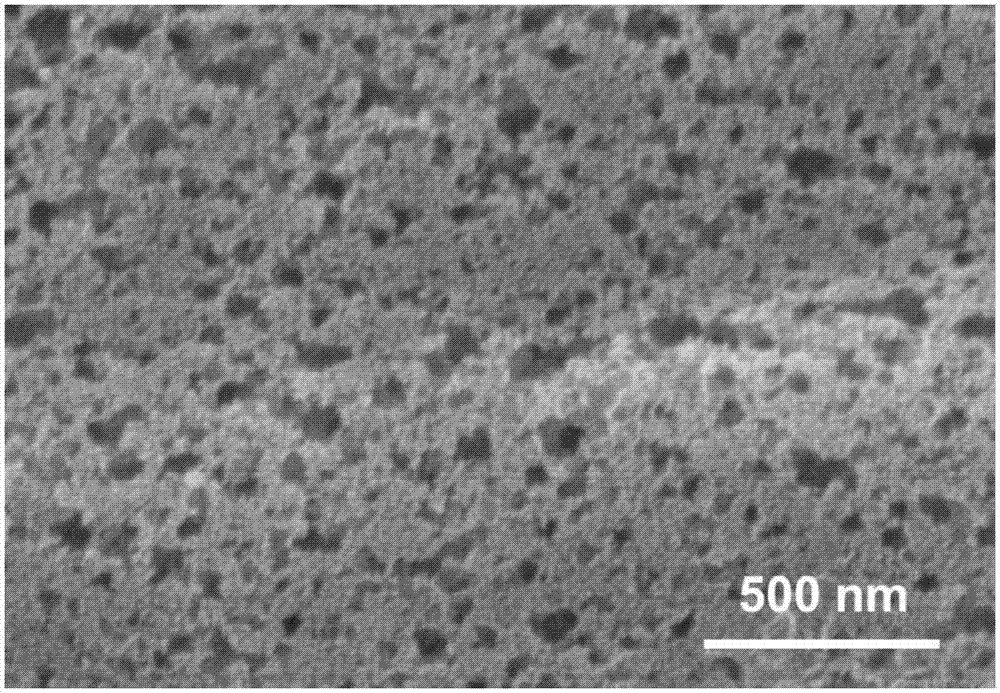Nitrogen-doped ordered porous high-conductivity graphene fiber, preparation method and application thereof
A technology of graphene fiber and nitrogen doping, which is applied in the manufacture of hybrid/electric double layer capacitors, hybrid capacitor electrodes, etc., can solve the problems of electrochemical performance improvement and limited space for improvement, no simultaneous realization, poor electrochemical performance, etc. , to achieve the effect of being conducive to electron transmission, good toughness, and improving the total capacitance
- Summary
- Abstract
- Description
- Claims
- Application Information
AI Technical Summary
Problems solved by technology
Method used
Image
Examples
Embodiment 1
[0049] Using 160-mesh natural graphite flakes as raw materials, the graphene oxide aqueous solution was prepared according to the Hummers improved method, and after centrifugation and concentration at a speed of 12,000 rpm or more for 50 minutes, a 14 mg / mL graphene oxide dispersion was obtained; 30 mL of the graphene oxide was dispersed solution and 210 mg urea (mass ratio of graphene oxide to urea is 1:0.5) were fully stirred and mixed evenly, and the above mixed solution was injected into a polytetrafluoroethylene cylinder with an inner diameter of 3 mm through a needle at an extrusion speed of 20 mL / h. Shaped microchannel and sealed at both ends, placed in an oven and heated at 90°C for 4h, then hydrothermally reacted at 160°C for 5h to obtain amino-functionalized graphene fibers; then cooled the cylindrical microchannel to room temperature Open the seals at both ends and dry at 90°C to obtain dehydrated amino-functionalized graphene fibers; the dried amino-functionalized g...
Embodiment 2
[0056] Using 100-mesh natural graphite flakes as raw materials, the graphene oxide aqueous solution was prepared according to Hummers' improved method, and after centrifugation and concentration at a speed of more than 13,000 rpm for 60 minutes, a 20 mg / mL graphene oxide dispersion was obtained; 30 mL of the graphene oxide dispersion was obtained. solution and 150 mg urea (mass ratio of graphene oxide to urea is 1:0.25) were fully stirred and mixed evenly, and the above mixed solution was injected into a polytetrafluoroethylene cylinder with an inner diameter of 4 mm through a needle at an extrusion speed of 10 mL / h. Shaped microchannel and sealed at both ends, placed in an oven and heated at 100°C for 1h, then hydrothermally reacted at 180°C for 4h to obtain amino-functionalized graphene fibers; then cooled the cylindrical microchannel to room temperature Open the seals at both ends, and dry at 80°C to obtain dehydrated amino-functionalized graphene fibers; place the dried ami...
Embodiment 3
[0060] Using 500-mesh natural graphite flakes as raw material, the graphene oxide aqueous solution was prepared according to Hummers' improved method, and after centrifugation and concentration at a speed of more than 10,000 rpm for 30 minutes, a graphene oxide dispersion of 8 mg / mL was obtained; 30 mL of the graphene oxide dispersion was obtained. Liquid and 1200mg of dicyandiamide (the mass ratio of graphene oxide and dicyandiamide is 1:5) are fully stirred and mixed evenly, and the above-mentioned mixture is injected through a needle with an inner diameter of 8 mm at an extrusion speed of 100mL / h. In the glass cylindrical microchannel and sealed at both ends, put it in an oven and heat it at 70°C for 6h, then hydrothermally react at 140°C for 10h to obtain amino-functionalized graphene fibers; then the cylindrical slender pipe After cooling to room temperature, open the seals at both ends, and dry at 100°C to obtain dehydrated amino-functionalized graphene fibers with furthe...
PUM
| Property | Measurement | Unit |
|---|---|---|
| Specific surface area | aaaaa | aaaaa |
| Conductivity | aaaaa | aaaaa |
| Length | aaaaa | aaaaa |
Abstract
Description
Claims
Application Information
 Login to View More
Login to View More - R&D
- Intellectual Property
- Life Sciences
- Materials
- Tech Scout
- Unparalleled Data Quality
- Higher Quality Content
- 60% Fewer Hallucinations
Browse by: Latest US Patents, China's latest patents, Technical Efficacy Thesaurus, Application Domain, Technology Topic, Popular Technical Reports.
© 2025 PatSnap. All rights reserved.Legal|Privacy policy|Modern Slavery Act Transparency Statement|Sitemap|About US| Contact US: help@patsnap.com



